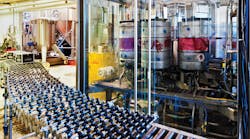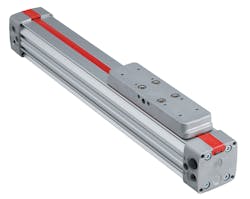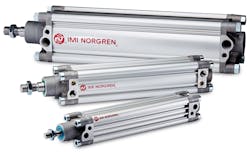Download this article in PDF format.
Say “thank you” to a pneumatic actuator next time you enjoy a craft beer. Or eat a watermelon. Or open a can of paint. Or interact with any of a number of objects, from cars to pills, in your daily routine.
The workhorses behind the scenes of our modern lives are linear actuators that push, pull, rotate, clamp, move and position the products (or the machines that make the products) we use every day. This article discusses the different types of actuators, also called cylinders, and then highlights ways in which actuator features can be selected for maximum efficiency and performance in specific applications.
Types of Pneumatic Actuators
The most familiar industrial pneumatic actuator is a rod-style cylinder. A rod attached to a piston inside a barrel or tube extends through a sealed opening at one end. The load is connected to, or contacted by, the rod. Compressed air controlled by a valve enters the barrel and moves the piston, which moves the rod. A port at the other end allows the air to escape. The rods of single-acting actuators are moved by compressed air and go back to their starting position by means of a spring return. Double-acting actuators are moved by compressed air in both directions.
Another type of pneumatic actuator is the rodless cylinder. Instead of being moved by a rod, the load is moved by an external carriage along the tube’s surface. Rodless cylinders save space and can deliver longer strokes than rod-style cylinders because the stroke is contained within the overall envelope of the cylinder. Rodless cylinders also handle high moment—the forces acting above, below, or to one side of the center of the piston.
Match the Actuator to the Application
Selecting the right actuator for an application starts by answering a few simple questions:
- What is the desired end result of the operation?
- What work will the actuator perform—lift, push, open/close?
- How large or heavy is the load?
- How far must it move?
- How quickly must the cylinder strike and recover?
- How will the motion be stopped?
- What is the operating environment?
Knowing what the cylinder must do helps designers understand how much force will be required, which will determine the bore size. It will also guide decisions about cycle speed, which determines throughput, productivity, longevity, and controllability. Designers may also need to calculate a cylinder’s air consumption for fast-cycling production equipment to ensure that the compressor system has sufficient capacity.
Classic, with a Twist
Pneumatic cylinders are a reliable technology, proven over decades of performance. It is easy to take them for granted or see them as commodities, but there is more variety in use and in design than you might think. Here are just a few quick examples.
Microbrewery
A craft brewery in Colorado needed to increase production capacity and efficiency, but had no room for a new production line. They solved the problem with a rotary kegging machine. Linear actuators on top of the machine control the motion of the kegs through the process.
These actuators integrate the valve, flow controls, cushioning, and sensors in the same package as the actuator, eliminating multiple valve islands, external components, tubing, and accessories. This combined with a clean external package not only saves space on the machine, but allows for easy, thorough washdown as required by this application.
The cleanline profile and reduced tubing of the integrated actuator and valve control cylinder mounted on top of this rotary kegging machine save space and make washdown easy. (Photo copyright Norgren Inc.)
Drapery Supplier
Rather than move yards of fabric through a sewing machine, a custom drapery supplier mounted the machines under rodless cylinders so that they would move precisely and evenly from sewing station to station. Rodless cylinders are especially well-suited to this application, because loads can be mounted on top, underneath, or along the side of the cylinder. They can also handle a stroke length up to 27 feet, and move in either direction with the same force.
Rodless cylinders, like the Lintra Cylinder from IMI Norgren, can be mounted horizontally or vertically and carry loads on top, underneath, or to the side. (Photo copyright Norgren Inc.)
Bread Baker
Getting bread to rise can be a delicate operation. An industrial bread-baking OEM found that excessive vibration during production was causing the bread to rise unevenly, or worse, not at all. Replacing existing pneumatic cylinders with cylinders that had a specialized elastomeric seal at the end of the tube reduced vibration, and product quality immediately improved. Best of all, this improvement was achieved without sacrificing cycle speed; therefore, with the same high throughput and less waste, productivity soared. And reduced vibration means longer machine life of both the cylinder and peripheral components.
Along these lines, check out IMI Norgren’s video on its actuators that employ "Ecology Seals":
Using cylinders with elastomeric seal cushioning dramatically reduces noise and wear caused by impact and vibration without significantly reducing the number of cycles over a typical eight-hour shift.
Melon Sorting
Linear actuators are used to sort all kinds of things, including watermelons. As the melon passes over a scale, a signal is sent to the actuator that corresponds to the melon’s weight. The actuator opens a gate that diverts the melon into the correct bin.
A new configuration being tested integrates the actuator with a soft pad at the end so that it can push the melon directly without damaging it. Not only does it reduce complexity and increase speed on the line, but this combination will be sold as a unit with a single part number, simplifying purchasing, stocking, and maintenance.
An expert cylinder supplier can combine the right actuator with other components to meet motion-control challenges, like sorting watermelons, accurately and efficiently. (Photo copyright Norgren Inc.)
Bucket Closure
A machine designed to automate closing of pails and paint buckets uses linear actuators in two directions. Horizontally, they move the pails down the line. Vertically, the actuator lowers an array of grippers that place the lid and then push it down securely.
When it comes time to design the next machine, processing line, or plant, get creative with a versatile pneumatic cylinder in one of its many forms. There’s almost certainly an actuator to perform any motion-control job, large or small, wherever compressed air is available. And the next time you open a package or go through a car-wash door (or eat a watermelon), thank a pneumatic actuator.





